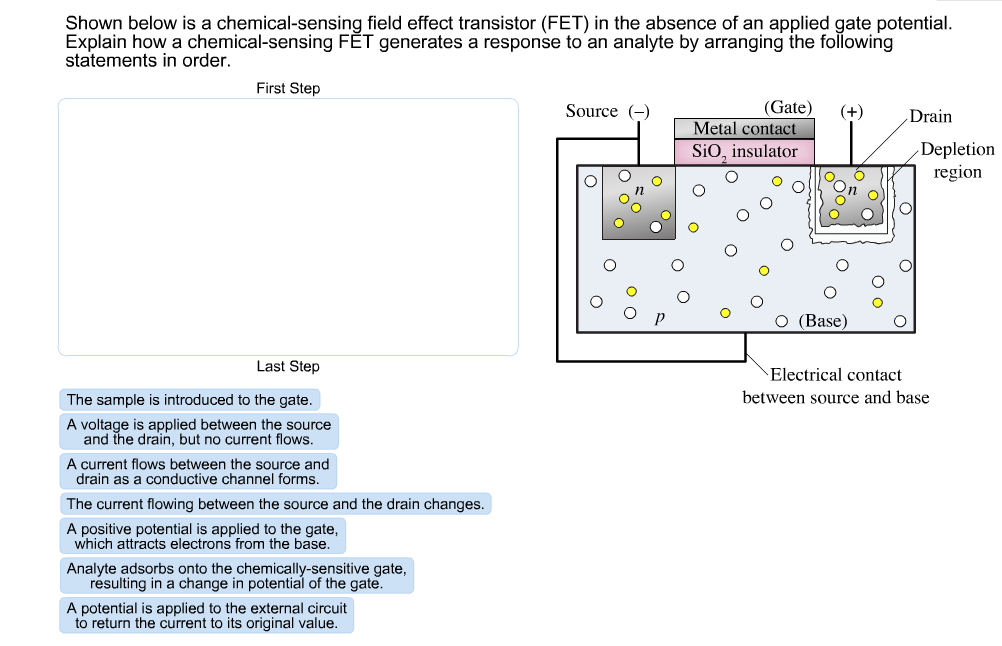Shown below is a chemical-sensing field effect transistor (FET) in the absence of an applied gate potential. Explain how a chemical-sensing FĚT generates a response to an analyte by arranging the following statements in order. First Step Last Step The sample is introduced to the gate. A voltage is applied between the source and the drain, but no current flows. A current flows between the source and drain as a conductive channel forms. The current flowing between the source and the drain changes. A positive potential is applied to the gate, which attracts electrons from the base. Analyte adsorbs onto the chemically-sensitive gate, resulting in a change in potential of the gate. A potential is applied to the external circuit to return the current to its original value. Source (-) (Gate) Metal contact SiO, insulator (+) O (Base) Drain Depletion region Electrical contact between source and base
Shown below is a chemical-sensing field effect transistor (FET) in the absence of an applied gate potential. Explain how a chemical-sensing FĚT generates a response to an analyte by arranging the following statements in order. First Step Last Step The sample is introduced to the gate. A voltage is applied between the source and the drain, but no current flows. A current flows between the source and drain as a conductive channel forms. The current flowing between the source and the drain changes. A positive potential is applied to the gate, which attracts electrons from the base. Analyte adsorbs onto the chemically-sensitive gate, resulting in a change in potential of the gate. A potential is applied to the external circuit to return the current to its original value. Source (-) (Gate) Metal contact SiO, insulator (+) O (Base) Drain Depletion region Electrical contact between source and base
Introduction to Chemical Engineering Thermodynamics
8th Edition
ISBN:9781259696527
Author:J.M. Smith Termodinamica en ingenieria quimica, Hendrick C Van Ness, Michael Abbott, Mark Swihart
Publisher:J.M. Smith Termodinamica en ingenieria quimica, Hendrick C Van Ness, Michael Abbott, Mark Swihart
Chapter1: Introduction
Section: Chapter Questions
Problem 1.1P
Related questions
Question
Please provide only typed answer solution

Transcribed Image Text:Shown below is a chemical-sensing field effect transistor (FET) in the absence of an applied gate potential.
Explain how a chemical-sensing FĚT generates a response to an analyte by arranging the following
statements in order.
First Step
Last Step
The sample is introduced to the gate.
A voltage is applied between the source
and the drain, but no current flows.
A current flows between the source and
drain as a conductive channel forms.
The current flowing between the source and the drain changes.
A positive potential is applied to the gate,
which attracts electrons from the base.
Analyte adsorbs onto the chemically-sensitive gate,
resulting in a change in potential of the gate.
A potential is applied to the external circuit
to return the current to its original value.
Source (-)
(Gate)
Metal contact
SiO, insulator
(+)
(Base)
Drain
Depletion
region
Electrical contact
between source and base
Expert Solution
This question has been solved!
Explore an expertly crafted, step-by-step solution for a thorough understanding of key concepts.
This is a popular solution!
Trending now
This is a popular solution!
Step by step
Solved in 2 steps

Recommended textbooks for you

Introduction to Chemical Engineering Thermodynami…
Chemical Engineering
ISBN:
9781259696527
Author:
J.M. Smith Termodinamica en ingenieria quimica, Hendrick C Van Ness, Michael Abbott, Mark Swihart
Publisher:
McGraw-Hill Education

Elementary Principles of Chemical Processes, Bind…
Chemical Engineering
ISBN:
9781118431221
Author:
Richard M. Felder, Ronald W. Rousseau, Lisa G. Bullard
Publisher:
WILEY

Elements of Chemical Reaction Engineering (5th Ed…
Chemical Engineering
ISBN:
9780133887518
Author:
H. Scott Fogler
Publisher:
Prentice Hall

Introduction to Chemical Engineering Thermodynami…
Chemical Engineering
ISBN:
9781259696527
Author:
J.M. Smith Termodinamica en ingenieria quimica, Hendrick C Van Ness, Michael Abbott, Mark Swihart
Publisher:
McGraw-Hill Education

Elementary Principles of Chemical Processes, Bind…
Chemical Engineering
ISBN:
9781118431221
Author:
Richard M. Felder, Ronald W. Rousseau, Lisa G. Bullard
Publisher:
WILEY

Elements of Chemical Reaction Engineering (5th Ed…
Chemical Engineering
ISBN:
9780133887518
Author:
H. Scott Fogler
Publisher:
Prentice Hall


Industrial Plastics: Theory and Applications
Chemical Engineering
ISBN:
9781285061238
Author:
Lokensgard, Erik
Publisher:
Delmar Cengage Learning

Unit Operations of Chemical Engineering
Chemical Engineering
ISBN:
9780072848236
Author:
Warren McCabe, Julian C. Smith, Peter Harriott
Publisher:
McGraw-Hill Companies, The